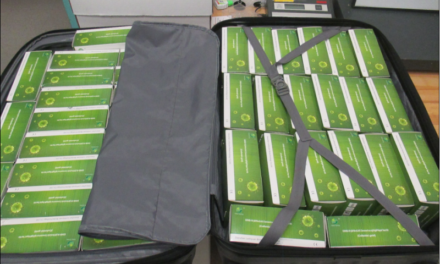WASHINGTON–More than 1,000 victims of child sexual abuse and online exploitation were identified or rescued in fiscal year 2015, as part of child exploitation investigations conducted by U.S. Immigration and Customs Enforcement’s (ICE) Homeland Security Investigations (HSI).
HSI special agents arrested or assisted in the arrest of 2,394 child predators worldwide in 2015, in child exploitation investigations ranging from possession, production and distribution of online child pornography to child enticement and child sex tourism.
In one of the first cases of the fiscal year, a 41-year-old California man, Blake Robert Johnston, was charged federally after his arrest by the Martinez (California) Police Department for transporting a 14-year-old girl from Oregon to northern California to engage in sex. According to court documents, Johnston allegedly met this girl, and several other minor victims, in online chatrooms, groomed them online, and then sexually abused them in order to produce child pornography. More than 60 child victims who were allegedly sexually abused or exploited by Johnston have been identified in 27 states and five countries. Additionally, through this investigation, HSI identified a number of additional child predators who allegedly communicated with Johnston and traded images of child sexual exploitation material.
“When a child is being sexually abused or exploited, it’s a race against time for investigators to identify and rescue that child,” said ICE Director Sarah Saldaña. “ICE is fully committed to conducting victim-centered investigations in which the identification, rescue, and stabilization of the victim is the first priority. When we identify a victim, more often than not we also find the perpetrator.”
Using new technology to identify and rescue victims
While new technologies have exponentially increased the volume of child exploitation material being traded and produced, they are also giving investigators the tools to identify more victims, and to intervene faster than ever, according to officials at the ICE Cyber Crimes Center.
In 2015, HSI analyzed more than 7.5 petabytes – or 7,500 terabytes – of data seized during search warrants; this equals 127.5 million hours of music; 150 million file cabinets filled with documents; more than a trillion pages of text; or almost 100 years of high definition video.
More than half of that data was related to child exploitation investigations. And, every year, HSI forensic analysts see about 40 percent more data collected from search warrants than the previous year.
This staggering amount of data means that finding victims in need of rescue can be like finding a needle in a haystack. HSI special agents address this issue by using the latest technology available to help process that data, and by focusing on victim identification.
Four years ago, in 2011, ICE’s Cyber Crimes Center launched a victim identification program to improve efforts to find and safeguard victims of child pornography. Since then, ICE has expanded this capability across the agency.
In 2015, the center expanded the footprint and capabilities of its forensic and victim identification laboratories and conducted victim identification training with special agents and analysts across all of its domestic field offices.
HSI also currently participates in a major collaborative effort known as Project VIC, which is helping to create technology solutions that reduce the amount of time to forensically process data, allowing special agents to concentrate their efforts on newly identified victims and reduce the time spent viewing previously discovered explicit material.
Seized data is now being analyzed in weeks, as opposed to six to nine months.
“Project VIC promotes a victim-focused methodology, speeds the identification of child victims and reduces officer burnout,” said Maura Harty, president and CEO of the International Centre for Missing and Exploited Children, the program coordinator for Project VIC. “Project VIC is very much a public-private partnership, with numerous law enforcement and other governmental entities, as well as private businesses combining forces to achieve our shared goals – there simply is no better way to help children.”
This year, as part of Project VIC, the Department of Homeland Security’s Science & Technology (S&T) Directorate’s Non-Cooperative Biometrics Program will evaluate and integrate cutting-edge technologies, such as facial recognition and text identification into current HSI forensic tools. The program is aimed specifically at technologies to aid in the fight against child sex abuse, but because those are some of the most technologically challenging cases, the program has implications for other missions as well. S&T plans to have the new tools ready for use by HSI within the next year.
These developments are having a direct effect on the number of sexually abused and exploited children being rescued and the speed with which they are found, according to investigators.
HSI’s recent efforts to safeguard and protect children have also included the use of media and social media to make public appeals to help identify and rescue children and locate suspected producers of child pornography. Tips from the public can be reported anonymously through HSI’s Operation Predator smartphone app, by phone or online, 24 hours a day, seven days a week. For additional information about wanted suspected child predators, download or visit the online suspect alerts page.
HSI cases around the country this year have also included:
- In March 2015, HSI sought the public’s help, through the media and social media, to identify an unknown child predator who was seen on video molesting an 8-year-old girl. More than 80 tips received by the HSI Tip Line helped investigators apprehend William Akers in Raleigh, North Carolina, less than 24 hours later. HSI special agents also rescued a 3-year-old child.
- In April 2015, HSI Los Angeles initiated an investigation based on a lead from law enforcement authorities in Switzerland. A search warrant executed a few months later resulted in the seizure of data that contained evidence of child pornography production involving two children, ages 6 and 14, at a Los Angeles residence. HSI arrested Francisco Tzarax and identified the two children in the videos. He is awaiting trial on state charges.
- In June 2015, Kevin Brian Keys was arrested in Michigan for sex trafficking a minor, and for production and distribution of child pornography. Prior to his arrest, a 16-year-old victim was reported missing and possibly abducted. Special agents recovered her in Minnesota in September 2014.
- In July 2015, Kevin Rebbie, a part-time children’s book author, was indicted in Pennsylvania after investigators discovered he had placed a hidden camera in a bathroom to record a 15-year-old minor, who he had also sexually abused. A forensic examination of electronic media seized from Rebbie revealed 19 deleted video files of sexually explicit material involving four additional minor victims. Further investigation led to the identification of two additional victims following his arrest.
- In October 2015, HSI Columbus (Ohio) and the Central Ohio Human Trafficking Task Force arrested Eric Chavis for conspiracy to produce child pornography. He and several co-conspirators were charged with producing pornographic rap videos which were uploaded to various social media sites. To date, HSI has identified three juvenile victims: one 16-year-old and two 17-year-olds.
The investigations were conducted under HSI’s Operation Predator, an international initiative to protect children from sexual predators. Since the launch of Operation Predator in 2003, HSI has arrested more than 14,000 individuals for crimes against children, including the production and distribution of online child pornography, traveling overseas for sex with minors, and sex trafficking of children.








